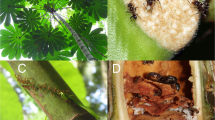Abstract
In myrmecophytes, plants with structures in which ants establish colonies, there is strong competition among ant queens for access to host plants. However, our knowledge of how queens of different partner species interact when attempting to colonize plants remains limited. The Amazonian myrmecophyte Maieta guianensis is colonized by queens of two ant species: Crematogaster laevis and Pheidole minutula. We elucidated the competitive ranking of queens of these species and tested the hypothesis that cooperative colony founding (pleometrosis) by P. minutula queens could alter this ranking. We found that C. laevis queens are behaviorally dominant to P. minutula when individual queens encounter each other. Despite being inferior in combat, however, P. minutula queens successfully colonized seedlings at similar rates whether they were placed alone or in concert with a C. laevis queen. This may have occurred because the smaller P. minutula queens frequently entered domatia before the more robust C. laevis queens. Although C. laevis queens can evict P. minutula queens that had previously colonized domatia, this was an infrequent phenomenon—perhaps because while not fatal, conflicts often resulted in serious injury. Furthermore, by colonizing the same plant cooperative P. minutula queens dramatically reduce the probability that C. laevis colonizes host-plants without reducing their own per capita rates of colonization success. To our knowledge, this is a novel benefit of pleometrosis, whose primary advantages have primarily been thought to occur after the critical stage of colony establishment. Given the decreased likelihood of colonization when faced with multiple P. minutula, it may be that C. laevis’ persistence at the landscape level is enhanced by such factors as priority effects, superior dispersal ability, or niche partitioning.

Similar content being viewed by others
References
Benson W.W. 1985. Amazon ant-plants. In: Amazonia (G.T. Prance and T.E. Lovejoy, Eds). Pergamon Press, New York, pp 239–266
Bierregaard R.O., Gascon C., Lovejoy T.E. and Mesquita R. (Eds). 2002. Lessons from Amazonia: the Ecology and Conservation of a Fragmented Forest. Yale University Press, New Haven. 478 pp
Bronstein J.L. 1998. The contribution of ant-plant protection studies to our understanding of mutualism. Biotropica 30: 150–161
Bruna E.M., Vasconcelos H.L. and Heredia S. 2005. The effect of habitat fragmentation on communities of mutualists: Amazonian ants and their host plants. Biol. Cons. 124: 209–216
Dáttilo F.C.W., Izzo T.J, Inouye B.D., Vasconcelos H.L. and Bruna E.M. 2009. Recognition of host plant volatiles by Pheidole minutula Mayr (Myrmicinae), an Amazonian ant-plant specialist. Biotropica 41 (in press)
Davidson D.W., Snelling R.R. and Longino J.T. 1989. Competition among ants for myrmecophytes and the significance of plant trichomes. Biotropica 21: 64–73
Feldhaar H., Fiala B. and Gadau J. 2005. A shift in colony founding behaviour in the obligate plant-ant Crematogaster (Decacrema) morphospecies 2. Insect. Soc. 52: 222–230
Fonseca C.R. 1999. Amazonian ant–plant interactions and the nesting space limitation hypothesis. J. Trop. Ecol. 18: 807–825
Frederickson M.E. 2006. The reproductive phenology of an Amazonian ant species reflects the seasonal availability of its nest sites. Oecologia 149: 418–427
Heil M. and McKey D. 2003. Protective ant-plant interactions as model systems in ecological and evolutionary research. Ann. Rev. Ecol. Evol. Syst. 34: 425–453
Hölldobler B. and Wilson E.O. 1990. The Ants. Belknap Press, Cambridge, Mass. 732 pp
Izzo T.J. and Vasconcelos H.L. 2002. Cheating the cheater: domatia loss minimizes the effects of ant castration in an Amazonian ant-plant. Oecologia 133: 200–205
Janzen D.H. 1966. Coevolution of a mutualisms between ants and acacias in Central America. Evolution 20: 249–275
Janzen D.H. 1967. Interaction of the bulls-horn acacia (Acacia cornigera L.) with an ant inhabitant (Pseudomyrmex ferruginea F. Smith) in eastern Mexico. Univ. Kansas Sci. Bull. 47: 315–558
Nery A.S. and Vasconcelos H.L. 2003. Growth and survival of incipient ant-colonies in two Amazonian ant-plants: effects of host plant, habitat, and mode of colony founding (Hymenoptera: Formicidae). Sociobiology 42: 151–162
Palmer T.M. 2004. Wars of attrition: colony size determines competitive outcomes in a guild of African acacia ants. Anim. Behav. 68: 993–1004
Palmer T.M., Young T.P. and Stanton M.L. 2002. Burning bridges: priority effects and the persistence of a competitively subordinate acacia-ant in Laikipia, Kenya. Oecologia 133: 372–379
Rico-Gray V. and Oliveira P.S. 2007. The Ecology and Evolution of Ant–Plant Interactions. University of Chicago Press, Chicago. 331 pp
Trager M.D. and Bruna E.M. 2006. Effects of plant age, experimental nutrient addition and ant occupancy on herbivory in a neotropical myrmecophyte. J. Ecol. 94: 1156–1163
Tschinkel W.R. and Howard D.F. 1983. Colony founding by pleometrosis in the fire ant, Solenopsis invicta. Behav. Ecol. Sociobiol. 12: 103–113
Vasconcelos H.L. 1991. Mutualism between Maieta guianensis Aubl., a myrmecophytic melastome, and one of its ant inhabitants: ant protection against insect herbivores. Oecologia 87: 295–298
Vasconcelos H.L. 1993. Ant colonization of Maieta guianensis seedlings, an Amazon ant-plant. Oecologia 95: 439–443
Vasconcelos H.L. and Davidson D.W. 2000. Relationship between plant size and ant associates in two Amazonian ant-plants. Biotropica 32: 100–111
Yu D.W. and Davidson D.W. 1997. Experimental studies of species-specificity in Cecropia-ant relationships. Ecol. Monogr. 67: 273–294
Yu D.W. and Pierce N.E. 1998. A castration parasite of an ant-plant mutualism. Proc. R. Soc. Lond., Ser. B: Biol. Sci. 265: 275–282
Yu D.W., Wilson H.B., Frederickson M.E., Palomino W., De la Colina R., Edwards D.P. and Balareso A.A. 2004. Experimental demonstration of species coexistence enabled by dispersal limitation. J. Anim. Ecol. 73: 1102–1114
Acknowledgments
We thank M. Stanton for comments on the manuscript and Waldete C. Lourenço, Wesley Dáttilo and Osmaildo F. da Silva for help in conducting the experiments. Financial support was provided by Brazil’s Conselho Nacional de Desenvolvimento Científico e Tecnológico (Grants 552680/2006-0 and 490518/2006-0), and the US National Science Foundation (grants DEB-0452720 and DEB-0453631). This is publication 529 in the BDFFP technical series.
Author information
Authors and Affiliations
Corresponding author
Rights and permissions
About this article
Cite this article
Izzo, T.J., Bruna, E.M., Vasconcelos, H.L. et al. Cooperative colony founding alters the outcome of interspecific competition between Amazonian plant-ants. Insect. Soc. 56, 341–345 (2009). https://doi.org/10.1007/s00040-009-0029-x
Received:
Revised:
Accepted:
Published:
Issue Date:
DOI: https://doi.org/10.1007/s00040-009-0029-x




